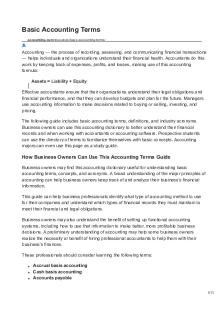Basic accounting Theories Principle PDF

| Title | Basic accounting Theories Principle |
|---|---|
| Author | Joshua Maldonado |
| Course | International Accounting |
| Institution | York College CUNY |
| Pages | 3 |
| File Size | 71.3 KB |
| File Type | |
| Total Downloads | 6 |
| Total Views | 176 |
Summary
Basic accounting Theories Principle...
Description
What Is Accounting Theory? Accounting fundamentals are critical for both accountants and business owners. The concepts underlying these theories have evolved into the real techniques used by accountants to ensure that money are managed and tracked effectively over time. Numerous concepts are included in fundamental accounting theory, including the cost principle, the matching principle, the materiality principle, conservatism, and the monetary unit assumption.
Cost principle: This principle necessitates the recording of assets immediately upon acquisition. These can be as simple as office supplies and factory equipment, or as complex as new franchises. Depending on the nature of the assets you are recording, they may depreciate over time. They should, however, be documented upon acquisition. The cost principle idea accounts for assets as they are acquired. Assets can be either tangible or intangible. Depending on the nature of the asset, it may be depreciated over time. Certain assets, such as real estate, may be depreciated for up to 30 years, while others, such as computers, may be depreciated for only three years. Depreciation is determined by the asset class and IRS regulations.
Matching principle:
This principle mandates that all transactions relating to a specific type of revenue be aggregated and reported as a single unit. According to the matching principle, expenses and accompanying income are always reported in the same period, such as a month, quarter, or year. This idea is applicable only to the accrual accounting technique. For example, if your organization pays a salesperson $2,000 in commissions for work performed in January, the expense should be recorded in January, even though the employee is not paid until the following month. This principle necessitates that accountants be meticulous and consistent in their paperwork. Accounting's matching principle treats a transaction as a unit, which means it accounts for all expenses linked with a particular revenue. Expenses are presented concurrently with revenue earned. For instance, in February, a sales commission may be given on things sold in January. In the matching principle hypothesis, the commission is accounted for in January, not in February, when it is paid. If you are employing the matching principle, maintain consistency in recording expenditures related with revenues on a monthly basis and avoid carrying over expenses.
Materiality:
The concept of materiality states that an accounting standard may be disregarded as long as the net effect on the books is insignificant enough that no one studying them will be deceived. Consideration must be given to evaluating if a particular transaction is significant enough, as materiality does not specify which transactions are judged most harmful. For example, if you have a small expense that will be spread out over a year, such as your wireless internet connection, it may not matter if the $240 is accounted for when you sign. The contract versus split into $20 chunks for the course of the contract's 12month term. Materiality varies according to the size of the business, as lower budgets require greater attention to each dollar spent, as it represents a greater proportion of the total. According to the Securities and Exchange Commission, a line item representing less than 5% of a budget does not need to be accounted for, but anything beyond that amount should be. Business owners can become engrossed in the task of counting pending monetary transactions prior to their recording. The materiality theory ensures that a corporation records only completed monetary transactions. This prevents a business owner from developing an erroneous sense of security as a result of pending contracts that may never materialize. Nonmonetary transactions may be included in reports but not in the underlying data and financial information.
Monetary unit assumption: This principle is concerned with obligations. To guarantee that your organization has enough cash on hand to pay its debts, conservatism mandates that all liabilities and potential liabilities be recorded as soon as they become apparent. This enables businesses to budget for unexpected expenses in the future. Existing and projected liabilities can have a significant impact on a business's financial performance. Conservatism theory takes into account all liabilities, even those that have not been completely realized. This prudent approach enables a corporation to plan for prospective obligations and retain sufficient cash flow to service the debt. This is most frequently used when suppliers supply goods on a 30-, 60-, or 90-day credit basis. This accounting approach at the highest level is ideal for large or worldwide companies. It evaluates the dollar's value and whether that value will remain constant or fluctuate over time. By forecasting probable currency swings, firms can prepare for future growth, expansion of production facilities, or investment opportunities. The monetary assumption principle examines whether the dollar's value will remain steady over time. This is critical for businesses operating in a worldwide environment or for production and inventory control planning. If you anticipate that dollar values will fluctuate, you may choose to raise or decrease output or purchase of supplies in response to the estimate. A dollar that does not purchase as much over the course of a year results in an increase in potential profit margins.
BASIC ACCOUNTING THEORIES Cost Principle Theory The cost principle idea accounts for assets as they are acquired. Assets can be either tangible or intangible. Depending on the nature of the asset, it may be depreciated over time. Certain assets, such as real estate, may be depreciated for up to 30 years, while others, such as computers, may be depreciated for only three years. Depreciation is determined by the asset class and IRS regulations.
Matching Principle of Accounting Accounting's matching principle treats a transaction as a unit, which means it accounts for all expenses linked with a particular revenue. Expenses are presented concurrently with revenue earned. For instance, in February, a sales commission may be given on things sold in January. In the matching principle hypothesis, the commission is accounted for in January, not in February, when it is paid. If you are employing the matching principle, maintain consistency in recording expenditures related with revenues on a monthly basis and avoid carrying over projected spending. A dollar that does not purchase as much over the course of a year results in an increase in potential profit margins. ....
Similar Free PDFs

BASIC NETWORK PRINCIPLE
- 201 Pages

Basic Definitions and Theories
- 4 Pages

Basic Accounting
- 29 Pages
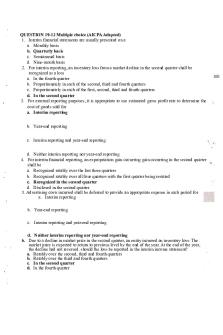
4 - Accounting Theories
- 4 Pages
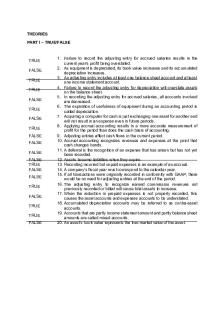
Theories on Accounting
- 4 Pages
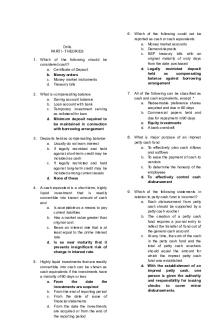
Accounting Theories with Answers
- 3 Pages
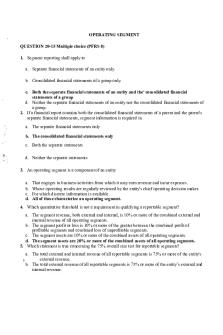
11 - Accounting Theories
- 11 Pages
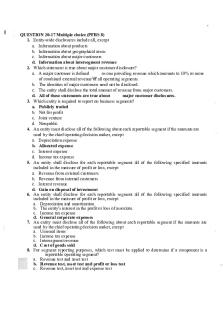
14 - Accounting Theories
- 3 Pages
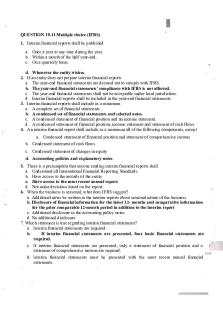
2 - Accounting Theories
- 4 Pages

Basic Accounting Problems
- 5 Pages

Basic Accounting Reviewer
- 13 Pages

Exercises for Basic Accounting
- 53 Pages

Basic Accounting Problems
- 3 Pages
Popular Institutions
- Tinajero National High School - Annex
- Politeknik Caltex Riau
- Yokohama City University
- SGT University
- University of Al-Qadisiyah
- Divine Word College of Vigan
- Techniek College Rotterdam
- Universidade de Santiago
- Universiti Teknologi MARA Cawangan Johor Kampus Pasir Gudang
- Poltekkes Kemenkes Yogyakarta
- Baguio City National High School
- Colegio san marcos
- preparatoria uno
- Centro de Bachillerato Tecnológico Industrial y de Servicios No. 107
- Dalian Maritime University
- Quang Trung Secondary School
- Colegio Tecnológico en Informática
- Corporación Regional de Educación Superior
- Grupo CEDVA
- Dar Al Uloom University
- Centro de Estudios Preuniversitarios de la Universidad Nacional de Ingeniería
- 上智大学
- Aakash International School, Nuna Majara
- San Felipe Neri Catholic School
- Kang Chiao International School - New Taipei City
- Misamis Occidental National High School
- Institución Educativa Escuela Normal Juan Ladrilleros
- Kolehiyo ng Pantukan
- Batanes State College
- Instituto Continental
- Sekolah Menengah Kejuruan Kesehatan Kaltara (Tarakan)
- Colegio de La Inmaculada Concepcion - Cebu


